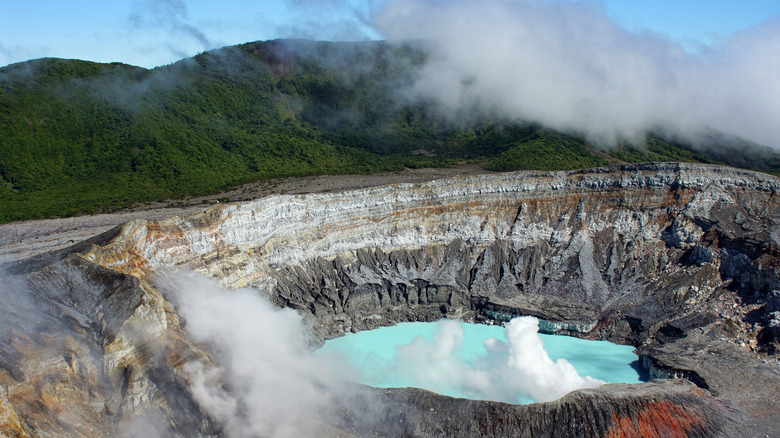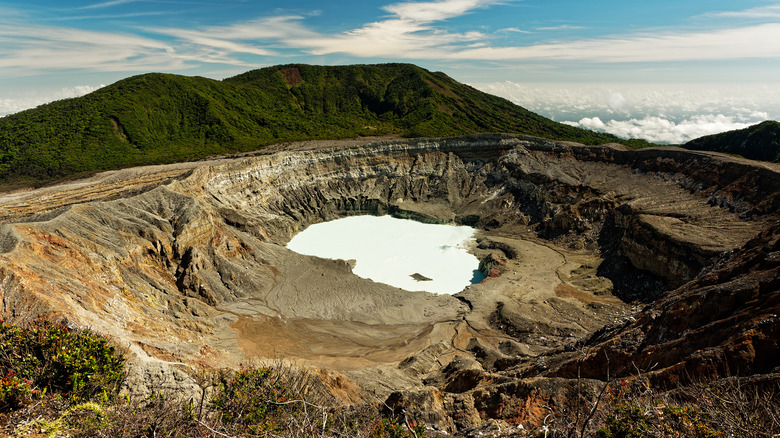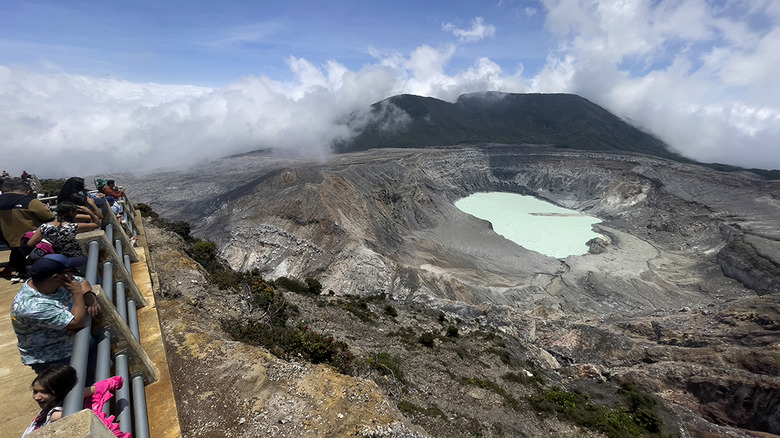One Of The Most Hostile Environments In The World Is A Bright Blue-Green Costa Rican Lake
With how lush the rainforest is in Costa Rica, it's easy to think there's no place in the country where animals and plants aren't thriving. However, things couldn't be more different inside Laguna Caliente. Located inside Costa Rica's Poás Volcano National Park, this hydrothermal crater lake is immediately recognizable thanks to its vivid blue-green color and the plumes of smoke that rise from its ultra-acidic waters. However, beneath its deceivingly beautiful surface, Laguna Caliente is made up of toxic metal content and extreme temperature fluctuations that range from comfortable to boiling.
The harsh conditions of Laguna Caliente, or "Hot Lagoon"are further exacerbated by recurrent phreatic eruptions, which cause sudden explosions of steam, ash, and rock. These violent events contribute to the lake's dynamic and unpredictable nature, making it a challenging environment for any form of life to survive. Visitors to Poás Volcano National Park, which houses the lake, can witness this natural phenomenon from a safe distance, but strict safety protocols are in place due to the volcano's active status.
Despite its inhospitable nature, Laguna Caliente has become a subject of intense scientific interest. Researchers are drawn to this extreme ecosystem not only to study life's adaptability on Earth, but also to gain insights into the potential for life on other planets, particularly Mars. For tourists, this adds an extra layer of intrigue to an already otherworldly visit, as they're not just observing a unique natural phenomenon but also a living laboratory for astrobiology.
Extreme conditions and unique microbial life
Laguna Caliente's water is a cocktail of deadly elements. The lake's pH levels can drop to nearly 0, making it more acidic than battery acid. On top of that, its waters are laden with toxic metals, creating an environment that is lethal to most living organisms. Temperature variations add another layer of complexity to this already hostile habitat, with the lake's standard range fluctuating between 100 and 194 degrees Fahrenheit, sometimes reaching boiling point. These extreme temperature swings, combined with the lake's chemical composition, create an environment that pushes the boundaries of life as we know it.
Visitors to the park might notice the absence of typical wildlife and vegetation, a stark reminder of the lake's forbidding nature. This is the result of the volcanic openings producing acid fog and rain that falls upon the surrounding area. These conditions have created a lifeless plain extending over 2 miles long and nearly 1 mile wide, despite being surrounded by green jungle.
Despite these seemingly insurmountable challenges, life finds a way to persist, and researchers have discovered a few types of microorganisms, primarily bacteria, that have adapted to survive in this extreme environment. These microbes possess genes that allow them to thrive in the lake's harsh conditions, demonstrating remarkable resilience and adaptability. While these microscopic inhabitants are invisible to the naked eye, their presence adds a fascinating dimension to the lake's story for scientifically-minded visitors. Adding a visit to Poás Volcano to your itinerary makes for an unforgettable vacation in Costa Rica.
Laguna Caliente and Mars exploration
The study of Laguna Caliente's microbial life has significant implications for our understanding of how life might exist in extreme environments beyond Earth. Some researchers believe that studying the biochemical pathways and survival strategies of microorganisms in Laguna Caliente could provide valuable insights into the potential for life on Mars, because the conditions are comparable to the red planet's acid-sulfate hydrothermal systems. For visitors to Poás Volcano, this connection to potential extraterrestrial life adds an exciting cosmic dimension to their adventure, transforming Laguna Caliente from a mere tourist attraction into a window of understanding life's potential beyond our planet.
Visiting Laguna Caliente is possible within the confines of Poás Volcano National Park but unsurprisingly, access is strictly controlled for safety reasons. The park itself is open daily between 7am and 2pm, and there is an elevated viewpoint from which visitors can safely view the lake. Per the park's website, visitors are required to sign a waiver before entering, and the park advises against visits by children under 12, pregnant women, the elderly, and those with certain health conditions.It is crucial to check the weather conditions before planning a visit as the park has been known to close temporarily due to increased volcanic activity. Moreover, the lake may not always be visible due to the fog. The website advises visiting early in the morning for the ideal visibility. If you are lucky enough to see this unearthly wonder, know that you are visiting one of the most otherworldly and mysterious places around the globe.


